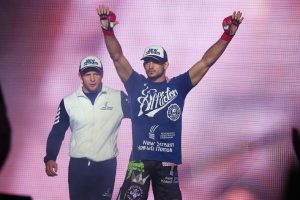
Most boys who suffered bullying as children and went on to watch kung fu movies have had the same dream: the one where you run off to a fantastical martial arts temple to learn how to fight, to make yourself powerful and to, ultimately, turn your life around. But who actually follows through on that dream? Well Matthew Polly did.
The author of the recent bestselling biography “Bruce Lee: A Life,” Polly’s first book was “American Shaolin.” It chronicled his own childhood trauma from bullying and how he got past it in, perhaps, over-the-top fashion by going all the way to China and becoming the first foreigner to study full-time at the famed Shaolin Temple.
Growing up in Topeka, Kan., Polly, 51, was a self-described skinny, dorky kid desperate to fit in with the cool kids at school.
He recalled, “They liked to smack me around. They’d push me into corners, punch me or kick me. I was desperate to be liked so thought if I just hung around them long enough letting them hit me they’d get tired of it and accept me. I didn’t realize at the time it wasn’t working, that I was the dorky kid they just didn’t want around. And because I let them hit me without fighting back, I felt like a coward.”
Though the physical abuse mostly stopped by high school, Polly said he was still a target of bullying through taunting and humiliation. But he’d already sensed there was a solution to his dilemma. The revelation came when he discovered the patron saint of all skinny dudes looking to stand up for themselves, Bruce Lee.
“When I first watched ‘Enter the Dragon’ I saw that Bruce was a somewhat scrawnily built guy who’d turned himself into this amazing fighter through martial arts,” he said. “I was 12 or 13 at the time and knew nothing about what martial arts were but I felt that if he could do that maybe I could, too.”
Matthew Polly
Without a lot of martial arts instruction available in Topeka in the 1980s, Polly waited until he got to college to begin training. He attended Princeton University where he tried taekwondo, then aikido and, finally, southern-style kung fu. But after a couple of years of this, he felt just as helpless as ever and no braver. So he decided to take more drastic measures – he’d run off to study at the Shaolin Temple.
This was the early 1990s, before the internet. Pretty much all most people knew – or thought they knew – about the Shaolin Temple came through popular entertainment like the original David Carradine “Kung Fu” television show. The show portrayed Shaolin as a nearly mythical Shangri La where warrior monks combined the world’s deadliest fighting arts with profound philosophical enlightenment. And what bullied kid wouldn’t want all that?
Polly picked up and flew to China making his way to the temple in Henan Province ostensibly for academic reasons – to continue the studies in Chinese culture and Zen Buddhism he’d begun in college – but in reality to learn how to kick ass like Bruce Lee. Becoming a foreign student at the temple, he began training in traditional kung fu as all beginners did. But after a few months, he was able to switch his training to sanda, a modern style of Chinese kickboxing which allows wrestling throws.
“Everyone starts with the traditional forms as an introductory class. After that you can continue with traditional kung fu, do wushu or do sanda. A lot of the movements in traditional kung fu are done more for cultural or historical reasons than for fighting, while wushu is mainly a gymnastic style,” he said. “But the guys who were fighters, the ones who would sometimes go out and fight in back alleys at night, they did sanda. That’s not to say the other styles couldn’t be used for fighting but their techniques have to be modified for that, it’s not their main purpose. But in sanda the movements are only there for hurting someone.”
With sanda, Polly was forced to put on boxing gloves and do what he’d always been afraid of, risk getting thoroughly punched out. Though he took his share of beatings from more experienced fighters, he learned getting beaten up wasn’t the end of the world. In his book he recounts what was, for him, a turning point when he accepted a challenge match from a visiting kung fu master in order to defend the honor of the Shaolin Temple.
Matthew Polly
The visiting master had wanted to fight one of the monks and Polly had flippantly offered to fight him, assuming his teacher would never allow a beginner, much less a foreigner, to represent the temple in a challenge match.
“I said I’d fight, not really meaning it. But then my teacher said, ‘Okay,’ and I was inadvertently forced to step up and do it. Like all things in life, if you feel fear and step up to overcome that fear, you get past it,” he said.
Polly won the challenge match, not only proving to himself that he was no coward but even experiencing what he described as a release of warrior spirit wanting to continue fighting even after his opponent surrendered. It was not the first time he’d sparred with someone at the temple and felt a growing rumble from what he called his inner “monster.”
Even at the Shaolin Temple, where wu de, or “martial morality,” was taught as part of the training, there were some students more aggressive than others, those who would go out looking for fights. But Polly was able to quickly tame his own dark side recognizing in martial arts practice that same concern Nietzsche expressed when he warned against fighting monsters lest you too become one.
“I think everyone who’s ever gone into a martial arts studio has known someone who was there training for the wrong reasons. But most people doing martial arts are like myself just training to improve and protect themselves,” he said.
After returning home, Polly became a writer, eventually penning “American Shaolin” followed by “Tapped Out,” his Plimptonesque foray into the world of mixed martial arts, and then his Bruce Lee biography. He said that, for him, martial arts training was the key to changing his life. He called it the most important thing he’s ever done. And he knows others have had similar experiences, which is why he’s spent so much of his career writing about martial arts.
“Yes, I’ve monetized my childhood trauma which is as American as it gets,” he joked. “And sure, I would have preferred a happier childhood but I learned you can turn your pain into something useful. Martial arts helped me do that.”
Motivation, Bullying
Black Belt Magazine
Bitcoin
Ethereum
Monero

Donate Bitcoin to The Bitstream
Scan the QR code or copy the address below into your wallet to send some Bitcoin to The Bitstream

Donate Ethereum to The Bitstream
Scan the QR code or copy the address below into your wallet to send some Ethereum to The Bitstream

Donate Monero to The Bitstream
Scan the QR code or copy the address below into your wallet to send some Monero to The Bitstream
Donate Via Wallets
Select a wallet to accept donation in ETH BNB BUSD etc..












